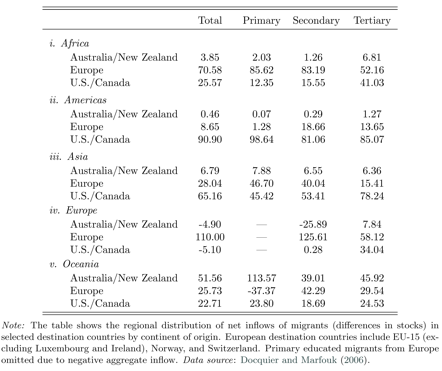Migration is a given. It happens. But what effect does it have on the wages of those already living in the destination country? In his BSE Working Paper, (No. 783), “The Effect of Immigration on Wages: Exploiting Exogenous Variation at the National Level” (August 2014), Joan Llull develops a new estimation technique and uses push factors and distance to investigate how wages in the United States and Canada respond to immigration.
Why has a consensus not developed on immigration and wage effects?
For the past five decades the OECD countries have experienced large inflows of migrants. But there hasn’t been an economic consensus as to the effect of immigration on the wages in destination countries. This can be seen in the wide-ranging literature estimates of the wage response to immigration, being anywhere from no effect or even marginally positive to substantially negative. In two very influential articles in this debate, Card (1990) finds that immigrants have virtually no effect on wages of those already living in the United States, and Borjas (2003) estimates wage responses to immigration at around -0.3 to -0.4, which imply that, for example, if the share of migrants in a worker population increased by 10% one would expect wages to decrease by about 3% or 4%. Given the differences in the measured responses it isn’t such a surprise that a consensus has not developed.
Why are the effects so wide-ranging?
The differences in results obtained in the literature may stem from the different ways that researchers are estimating the wage effect. Most of the research articles in this topic do the following exercise: they compare the evolution of wages in different labor markets that experience different levels of immigration. Some papers define these labor markets geographically (metropolitan areas), and others as skill groups (assuming that immigrants with a given education and experience mainly compete with native workers with the same characteristics). And, in general, these papers have to deal with the problem that immigrants do not randomly enter labor markets. In search of better economic opportunities, immigrants penetrate labor markets that offer relatively high wages, building an artificial positive association between immigration and wages that has nothing to do with a causal effect of the former on the latter.
In order to correct for this artificial association, different authors have tried to analyze situations in which immigration happens due to reasons that are unrelated to the labor market. The paper by Card (1990), and others that followed, exploit what we call a natural experiment. Card analyzes the evolution of the Miami labor market (in comparison to a few similar labor markets in the United States) in the aftermath of the Mariel Boatlift, a mass emigration of Cubans who departed from Cuba’s Mariel Harbor for the United States between May and October in 1980, when an unlikely sequence of events culminated in Castro’s declaration that Cubans wishing to emigrate to the United States were free to leave from the port of Mariel. In a few months, the labor force of Miami was increased by 7%, with no relation to Miami’s relative good evolution of wages.
One of the drawbacks of natural experiments, though, is that it is not clear how to extrapolate the conclusions to other (less rare) situations. As a result, researchers have tried to obtain more general, quasi-experimental variation in immigration that is unrelated to relative economic opportunities among labor markets. This is what economists call instrumental variables. More specifically, they try to find determinants of why individuals migrate to some labor markets and not others that are unrelated to labor market opportunities. Thus, the goal is to compare the evolution of wages in different markets that experience different levels of predicted (and not necessarily actual) immigration.
To illustrate how such instrumental variables work, consider the following example. Imagine a situation in which there were only two labor markets, A and B, and two periods of time. Consider an instrumental variable that predicts that in the second period, immigration increases in labor market A and stays constant in labor market B. The effect of immigration on wages is calculated as the relative change in wages in labor market A between the first and the second periods, compared to change in labor market B.
In an idea that has been used extensively by many researchers, Altonji and Card (1991) propose the following instrumental variable: past settlements of immigrants from a given national origin can predict the location of new immigrants, because of the existence of immigrant networks. Therefore, they take the economy wide inflow of immigrants between 1970 and 1980, and split it across U.S. metropolitan areas based on the distribution of immigrants from each national origin into each U.S. metropolitan area in 1970. And then, they relate the relative change in wages to the relative predicted inflow of immigrants.
As noted by Borjas (1999), using past settlements of immigrants as an instrumental variable is not necessarily a good idea. The reasons why immigrants in the past moved to certain cities and not others could be related to the reasons they would do so now. For example, maybe certain cities were offering relatively good wages in the past and keep doing so today, and that is what attracted lots of immigrants in the past and keep attracting them in the present. If that were the case, the artificial correlation between (predicted) immigration and wages would not be eliminated.
Llull offers an alternative set of instrumental variables that, combined with a new estimation technique that he proposes, arguably corrects for this artificial correlation.
What about that “push”?
Following one of the strands of the literature described above, Llull defines labor markets as skill groups (namely education-experience cells). A valid instrumental variable should predict different levels of immigration in a given education-experience cell at different points in time for reasons unrelated to better labor market opportunities.
In his search of instruments, instead of looking at “pull factors” (or reasons to migrate that are inherent to the destination labor market), like the immigrant networks in Altonji and Card (1991), Llull proposes looking at “push factors” (or events in the origin country that motivate migration). He considers the following:
- Civil wars or conflict
- Quality of political regime
- Natural disasters
- Economic indicators
Either of these variables provides a reason for migrants to move out of their countries. Llull considers them separately, each providing a set of quasi-natural experiments that provides the desired random variation in immigration.
However, this alone will not help, as it will not predict different levels of immigration in different education-experience cells. Therefore, he needs to use extra information. In particular, he combines two additional pieces. The first one is distance between the origin country and the destination. For instance, the U.S. would have received a relatively larger amount of Mexican workers in the 1990s if the Balkans war had occurred in Mexico, as compared to the number of immigrants it actually received from the then Yugoslavia. Therefore, distance mitigates the effect of push factors on migrant flows.
The second piece comes from the observation that the mitigating effect of distance differs across different skill groups. For example, the mitigating effect may be more severe for those who are less educated and/or those who are middle-experienced. The intuition is that less educated migrants (as well as middle-experienced migrants, who have likely developed families) find migration more costly, and so may tend to immigrate to closer destinations relative to their home country.
The table below reports some evidence suggesting that of distance differentially acts as a mitigating factor at different educational levels. In particular, it shows the percentage of all migrants from a certain region of origin and a certain education group that was received into each of three OECD big regions between 1990 and 2000:

The table suggests that, while the U.S. and Canada tends to attract more migrants from the Americas than any other destination region and Australia and New Zealand attract more migrants from Oceania than other regions, they especially do so among primary educated migrants. For example, the U.S. and Canada attracted 90% of all migrants from the Americas, but 98% of all Americas primary educated migrants, and only 85% of all tertiary educated.
In sum, Llull argues that either of the push factors listed above, together with distance, predicts different levels of migration in different education-experience groups at different points in time, with no connection to available economic opportunities for immigrants in each labor market. Therefore, each push factor acts as if it was a set of natural experiments of a different kind.
So immigrants are affecting wages?
Llull analyzes both the United States and Canada together, and the United States alone. He proposes a new estimation technique that allows using the previous instrumental variables in a systematic way. He finds very similar estimates of the wage response for the U.S. and Canada.
In order to quantify the error that is made if the artificial association between immigration and wages is not cleared out, he first estimates the wage response to immigration without using the proposed instrumental variables. In this exercise, he finds the wage response to be between -0.3 and -0.45 (very similar to Borjas (2003), who does not correct for the artificial correlation described above).
However, when he uses the push factor/distance/skill-group information to build instrumental variables along with his new estimation technique, he estimates wage responses in the range of -1.15 to -1.30. This result implies that, if the share of migrants increased by 10% one would expect wages to decrease by about 11.5% or 13%.
What is interesting is that his estimates of the wage response to immigration are very stable to the use of different push factors. This is interesting because, as each push factor offers some sort of sequence of natural experiments of a given kind, the fact that different kinds of sequences of natural experiments give the same result suggests that results can be extrapolated out of migration that occurs for a specific push factor.
These estimates are also found to be robust, wherein the use of different sets of data for each push factor and distance produce very similar wage responses. For example, with regards to distance Llull uses various measures of linguistic distance (or relation between the language spoken by the migrant and that spoken in the destination country) instead of physical distance.
Therefore, with estimates that produce an average wage response of -1.2 it seems like immigration is affecting wages in the U.S. and Canada. However, this cannot be seen as a final response. For example, his analysis does not take into account the fact that natives can adjust their education and move to another education-experience group that experience lower immigration, mitigating the effect of immigration (an issue he analyzes in another Barcelona GSE working paper). Yet, the article provides an important step showing that existing papers in the literature do not clear out completely the artificial association created by migration decisions responding to the search of better economic opportunities.
References
Altonji, Joseph G. and David E. Card “The Effects of Immigration on the Labor Market Outcomes of Less-skilled Natives,” in John M. Abowd and Richard B. Freeman, eds., Immigration, Trade and the Labor Market, Chicago: University of Chicago Press, 1991, chapter 7, pp. 201–234.
Card, David E. (1990) “The Impact of the Mariel Boatlift on the Miami Labor Market.” Industrial and Labor Relations Review, 43 (2):245–257.
Borjas, George J. (1999) “The Economic Analysis of Immigration,” in Orley C. Ashenfelter and David E. Card, eds., Handbook of Labor Economics, Vol. 3A, Amsterdam: North-Holland Publishing Company, 1999, chapter 28, pp. 1697–1760.
Borjas, George J. (2003) “The Labor Demand Curve Is Downward Sloping: Reexamining the Impact of Immigration on the Labor Market.” Quarterly Journal of Economics, 118 (4): 1335–1374.

